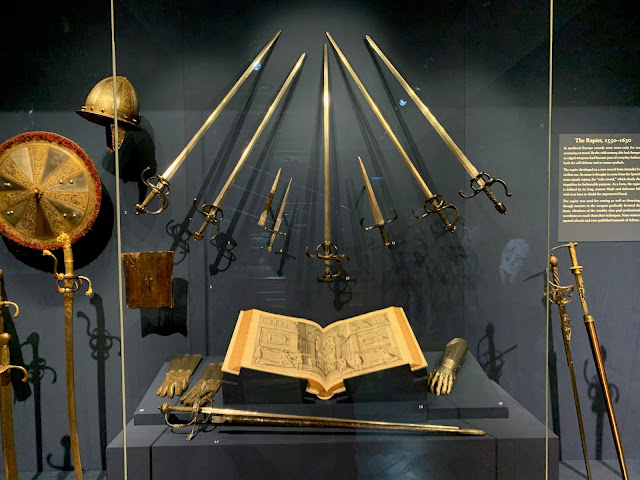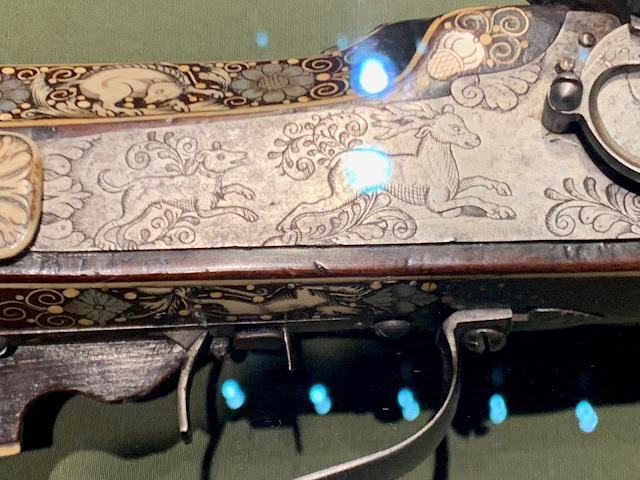A few days ago my wife and I decided to go to the Art Institute of Chicago. It is one of my favorite places in the city, perhaps in the world - there are so many beautiful and thought-provoking pieces there. If you are ever in the city, put it on the top of your list. It really is a world class collection, and I wanted to talk about one of the highlights from this trip - the new Arms and Armor gallery. The last time we went, this, my favorite exhibit, was closed as they redid the gallery. I’ve loved that exhibit ever since I was a little kid. I was totally blown away the first time I saw it, and it continues to be a source of fascination for me.
I've always been enthralled by art depicting weapons and weapons that are pieces of art. As a kid, I enjoyed the Osprey books (of which I now have like two hundred pee dee effs) as well as black and white illustration - things like David Macaulay's Castle, or various pictorial archives and encyclopedias of weaponry such as A Glossary of the Construction, Decoration and Use of Arms
and Armor: in All Countries and in All Times. I loved the artwork not just of beings but also of weapons in the various tomes I had collected - the MM, PH, and DMG of course, but also Deities and Demigods (with the Cthulhu and Melnibonean mythos! Sadly long gone now) and a handful of modules - White Plume Mountain, Expedition to the Barrier Peaks, The Lost Caverns of Tsojcanth, etc. I used to sketch weapons when I was younger - swords mostly, but not always.
The elaborate fantasy scenarios I imagined as a kid, inspired by Dungeons & Dragons, were enriched by visits to the museum and being able to see real examples of the arms and armor. This time around I took a lot of photos and wanted to share a few here. More professional photos of almost the entire collection are online as well at https://www.artic.edu/collection. Most of what is on display is European from about 1500 - 1700, but the collection includes much more modern weaponry as well. For example, though it isn't currently on display, there is a pretty extensive collection of firearms from 1850 to 1970 or so, everything from Colt Navy Revolvers to Lugers to a Walther Model PPKS Semi-Automatic Pistol, all rather tastefully gilded and decorated by Raymond Wielgus.
This stuff is invaluable as a reference for writers and artists who want to describe unique weapons and armor, and of course, they are all quite beautiful. Blinging out one's tools of death seems to be a pretty universal thing, doesn't it? Writing this made me remember visiting Odawara Castle - the interior of that castle has been converted to a museum and one of the things they have on display are swords. I was looking at one of these, a katana with all the hardware removed, no handle or guard, just the blade itself - and a little boy and his mom were nearby. I heard the mom say something like "Kono o mite!" - "Hey look at this!" and the kid, maybe seven or eight years old, running up to the glass and exclaiming "Kireii!" - "Pretty!" And he was right. The blade was beautiful. It seemed to be almost equal parts a deep carbon grey and white, gleaming in the museum lights. And there was an absolutely gorgeous hamon that ran its length in the koshi no hiraita style, an undulating wave dividing light from dark - something like this blade:
As a species, we seem to have a fascination with beautiful, deadly things. They are such strong images, when used in art they sometimes leave an impression that outlasts the plot or even the characters. I think of Terminus Est, or the Judge's silver-chased rifle inscribed with "Et In Arcadia Ego." I forget the names of even fairly major characters in the New Sun series or in Blood Meridian, but I retain the images of those weapons.
Some of the engraving, carving, and etching on display at the museum and it is breathtaking. Some is intricate and witchy, some is simple and bold. Some of it is even funny! And since you are very likely tired of listening to me ramble, I'll get to the meat of this post without further ado.
The Guard of the Electors of Saxony (~1580)
As the electors derived much of their wealth from the Saxon silver mines, they equipped their officers with swords and daggers adorned with silver plaques. The morion is painted black with gilt etching to match the guard’s black-and-gold livery. Guards mounted on horseback carried a pair of wheellock pistols, or puffers, while those on foot bore staff weapons such as this glaive and halberd. The powder flask features a carved figure of a Saxon guard from about 1600.
Triple-Barreled Wheellock Pistol (1610-20) - Top
The half minute needed to wind and load a wheellock pistol
led to the invention of various multilock and multibarrel systems. Here three
independent pistols are stocked together with alternating triggers.
To fire the weapon, the shooter need only rotate the grip on
the gun and pull the next trigger.
Wheellock Rifle of Archduke Charles of Styria (1571)
The engraving on this is just amazing. The cheek shows the Judgement of Paris. Further up is Cleopatra committing suicide
with an adder at her breast.
Wheellock Rifle of Emperor Leopold I (1664)
The carvings on this are wild – they show a hunter roasting on a spit with his faithful hound in a
cauldron. There is a German inscription along
the rifle translates as:
To us hares came the chance that we could roast dog and
huntsman who formerly skinned and ate us.
We avenge them with these measures.
A hound chasing a stag in this VERY close up on the last piece.
I have many more photos but that's all I'll subject you to for the moment. And check out the site -I'm pretty certain that only 50% or less of the collection is on display, but there are photos over there of just about everything I think.
The other major highlight from this trip was an exhibition devoted to the works of Remedios Varo which opened this last summer. I was not very familiar with Varo's work before seeing this exhibit - I think the only reason I was aware at all is probably because of the Was It Likely blog (bless you Screwhead for your exquisite taste in art and for attributing all of it). I really enjoyed it. As I examined her work, it struck me that she and John Blanche have stylistic similarities. I hope I get a chance to do a write up on that next time around!


































These are great photos! I hate taking photos, whenever I go to a museum I'll take maybe one or two the entire way through. I've probably been to the Art Institute of Chicago but if I have it would have been years and years ago. I have a somewhat less generous opinion about the relationship between art and weapons lol, but looking at these, I can appreciate them for what they are.
ReplyDeleteI hear you! In museums I don't mind it so much, but some places I can't do the camera thing - anywhere where participation is more than just visual, I guess, although that's a sloppy way to say it - but things like concerts for example, the camera can relegate one to a position where they are producing their life rather than experiencing it, and generally that's where I would draw the line for myself.
Delete